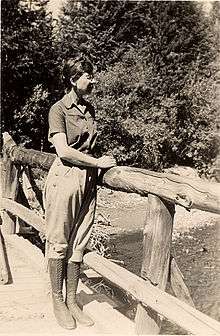Isabel Bassett Wasson


Isabel Bassett Wasson (1897–1994) was one of the first female petroleum geologists in the United States, the first female ranger at Yellowstone National Park, and also one of the first interpretive rangers (male or female) hired by the National Park Service.
Biography
Wasson was born Isabel Bassett in Brooklyn, NY on January 11, 1897, daughter of urban planner Edward Bassett and Annie Preston Bassett, and sister of inventor and engineer Preston Bassett. Wasson graduated Phi Beta Kappa from Wellesley College in 1918, majoring in history so she could take a wide range of science courses. She took classes in geology after graduation at the University of Chicago and the Massachusetts Institute of Technology. She met her future husband, petroleum geologist Theron Wasson, whom she married in 1920, while working towards a master's degree in geology at Columbia University, which she finished in 1934. They had three children: Elizabeth W. Bergstrom, a biologist; Edward B. Wasson, a petroleum geologist; and Anne Harney Gallagher, an art historian. Theron and Isabel divorced in 1953 and she did not remarry. Wasson worked as a petroleum geologist in her husband’s office at the Pure Oil Company for several years. After 1928 she spent over 50 years in River Forest, IL, teaching science in the local public schools, lecturing, bird watching (ornithology), and mentoring generations of young naturalists. From 1953-1954, Wasson served as President of the Chicago Ornithological Society. Wasson also taught classes at the Morton Arboretum in Lisle, Illinois. She died in La Grange Park, IL, in 1994.[1][2][3]
Wasson became one of the first interpretive rangers hired by the National Park Service, and the first female ranger at Yellowstone National Park. She was hired when Horace Albright, then the Park Superintendent, heard her lecture on geology to a group of her family and friends who were visiting the park in the summer of 1919 on a tour of national parks organized by the Brooklyn Daily Eagle. Albright invited her to return in the summer of 1920 to lead interpretive tours and give lectures about the geology of the park, which she did. She gave over 200 public talks on the geology of the park that summer, and is credited with setting the template for interpretive talks by NPS rangers. Albright also asked her to train the hotel bellhops to give talks similar to hers, but she concluded that they lacked the background in geology to do this. She suggested instead that the park hire college students on summer break to give talks, and this became a tradition at Yellowstone and many other parks.[4] Albright invited her to return again in the summer of 1921, but she declined because she was pregnant. She inquired about returning in 1922 but others had been hired to do similar work.[5] [6] [7] [8] [9] [10]
References
- ↑ "Isabel Wasson obituary". New York Times. February 25, 1994. Retrieved May 9, 2011.
- ↑ "Isabel Bassett Wasson, A Teacher And Geologist". Chicago Tribune. February 24, 1994. Retrieved February 11, 2015.
- ↑ Bassett, Howard and Lorion.The Descendants of Charles and Elvira Bassett. 1972.
- ↑ Watry, Elizabeth A. Women in Wonderland: Lives, Legends and Legacies of Yellowstone National Park. Chapter 7. (Helena, Montana: Riverbend Publishing, 2012)
- ↑ Smith, Diane Marie, (Thesis for MA in History).“What One Knows One Loves Best”: A Brief Administrative History Of Science Education In The National Parks, 1916–1925., Montana State University, 2004. Accessed June 16, 2012.
- ↑ Krieger, Karen. (1997). "Women of Yellowstone. ',Cultural Resource Management,'," (PDF) 20 (3,). Retrieved May 9, 2011.
- ↑ Oral history by Wasson, recorded 1978, describes her work at Yellowstone; item 00-6 (cassette) accessdate=June 16, 2012
- ↑ Robert Goss. "Calls her "Yellowstone’s 1st woman ranger"". Retrieved May 9, 2011.
- ↑ Kiki Leigh Rydell and Mary Shivers Culpin. "Managing the "Matchless Wonders," A HISTORY OF ADMINISTRATIVE DEVELOPMENT IN YELLOWSTONE NATIONAL PARK, 1872–1965, Nature is the Supreme School-Teacher" (PDF). Retrieved May 9, 2011.
- ↑ Yellowstone Park Foundation. "Yellowstone Figures Profiled in Ken Burns Film". Retrieved February 11, 2015.
Further reading
- Kaufman, Polly Welts. National Parks and the Woman's Voice: A History. (Albuquerque: University of New Mexico Press, 1997, and 2nd edition, 2006)
- Wasson, Isabel B. A Village Grows up on a Sandbar. Forest Leaves (River Forest, Ill.), June 22, 1977.
- Wasson, Isabel B. Birds. (Chicago: Follett Publishing Co., 1963)
- Wasson, Isabel B. Authority versus experience. Religious Education 23: 144–149 (Chicago: Religious Education Association, July–September 1938).
- Wasson, Isabel B. What I want the schools to teach my child. Educational Trends 6(8): 14–16 (Evanston: Northwestern University, October–November 1938).
- Wasson, Theron and Isabel B. Wasson. Cabin Creek field, West Virginia. AAPG Bulletin, July 1927, v. 11, p. 705-719. Citation online